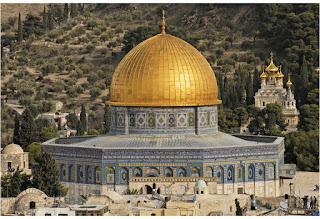Who- Muslim scribes
What- Folio from the Blue Koran with 15 lines of Sura 2,
When- 9th to mid 10th century
Where- Kairouan, Tunisia
Why- calligraphy held place of honor
How- Ink, gold, and silver on blue-dyed vellum
Who- Abd al-Malik
What- Aerial view of the dome of the Rock
When- 687-692
Where- Jerusalem
Why- here Muhammad began his miraculous journey to heaven marks the triumph of islam
How- domed octagon
Who- Nasrids
What- Muqarnas dome, Hall of the Abencerrajes, Palace of the lions
When- 1354-1391
Where- Alhambra, Granada, Spain
How- octagonal drum, carved stucco muqarnas, rose colored stone
Who- Umayyad caliphs
What- Plan of the Umayyad Jerusalem Palace
When- ca 740-750 (After Alberto Berengo Gardin)Where- Mshatta, Jordan
Why- Umayyad palaces included elaborate bathing facilities, which were an inheritance from Roman influences
Who- Ottoman architect Sinan
What- Illuminated tughra
When- ca 1555-1560
Where- Constantinople, Istanbul, Turkey
Why- for Suleyman the Magnificent
How- Ink, paint, and gold on paper
When- About 1354
Where- Isfahan, Iran
Why- Exemplifies perfect union of Islamic Calligraphy
When- Early 10th Century
Where- Bukhara, Uzbekistan
How- Baked Bricks
What- Prayer Hall Of Mezquita
When- 800CE-1000CE
Where- Cordoba, Spain
How- 36 piers, 514 columns
Who- Pyxis of al-Mughira
What- Ivory Pyxis
When- 986
Where- Cordoba, Spain
How- Ivory
What- Detail of Mosaic in courtyard of Great Mosque
When- 706 to 715
Where- Damascus, Syria
Why- To show expansion of population




























